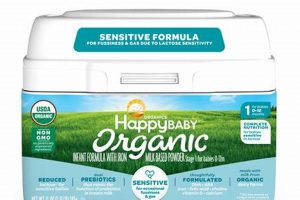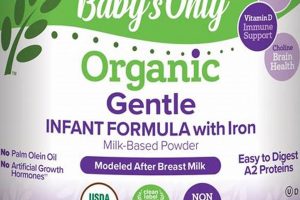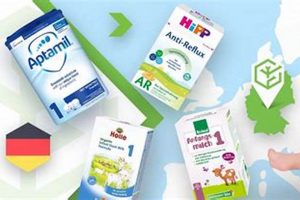A specialized infant nutrition product, extensively hydrolyzed formulas are designed for babies with cow’s milk allergy or other conditions requiring easily digestible proteins. The protein in these formulas is broken down into smaller fragments, significantly reducing the likelihood of triggering an allergic reaction. An example would be a commercially available product marketed for infants experiencing sensitivities.
These formulations play a crucial role in managing feeding difficulties and promoting healthy growth in infants with specific dietary needs. Their introduction marked a significant advancement in pediatric nutrition, offering a viable alternative for infants unable to tolerate standard formulas. By providing essential nutrients in a readily absorbable form, they support optimal development and alleviate symptoms associated with protein intolerance.
This article will further examine the specific ingredients, usage guidelines, potential benefits, and considerations associated with extensively hydrolyzed infant formulas, as well as a comparison to other types of infant nutrition products.
Guidance on Using Extensively Hydrolyzed Infant Formula
The following recommendations are intended to provide practical advice for caregivers utilizing specialized infant formulas designed for managing allergies or sensitivities. Proper preparation and handling are crucial for ensuring infant safety and optimal nutritional benefit.
Tip 1: Consult a Healthcare Professional. Prior to initiating the use of extensively hydrolyzed formula, consult with a pediatrician or registered dietitian. Professional guidance ensures the formula is appropriate for the infant’s specific needs and health condition.
Tip 2: Adhere to Preparation Instructions. Strictly follow the manufacturer’s preparation guidelines regarding powder-to-water ratios and mixing procedures. Deviations may impact nutritional content and digestibility.
Tip 3: Utilize Sterilized Equipment. Employ thoroughly sterilized bottles, nipples, and measuring devices to minimize the risk of contamination and potential infection.
Tip 4: Prepare Formula Freshly. Prepare each bottle immediately before feeding. Prepared formula should not be left at room temperature for more than one hour to prevent bacterial growth.
Tip 5: Properly Store Prepared Formula. If not used immediately, prepared formula should be refrigerated promptly and used within 24 hours. Discard any remaining formula after this period.
Tip 6: Monitor Infant Tolerance. Closely observe the infant for any signs of intolerance, such as changes in stool consistency, skin rashes, or increased fussiness. Report any concerns to a healthcare provider.
Tip 7: Ensure Adequate Hydration. Maintain adequate fluid intake, especially during periods of hot weather or illness. Consult with a healthcare professional regarding appropriate fluid supplementation if needed.
Proper utilization of extensively hydrolyzed formula, in conjunction with professional medical advice, can contribute significantly to the well-being and nutritional management of infants with specific dietary requirements.
The following sections will delve into specific considerations regarding long-term use and potential alternatives to extensively hydrolyzed infant formulas.
1. Protein Hydrolyzation
Protein hydrolyzation is the cornerstone of specialized infant formulas designed for managing cow’s milk protein allergy. This process fundamentally alters the structure of proteins, mitigating their allergenic potential and enhancing their digestibility for sensitive infants.
- Mechanism of Action
Protein hydrolyzation involves breaking down complex protein molecules into smaller peptides and amino acids. Enzymes are used to cleave the peptide bonds within the protein structure, effectively reducing the size of the protein fragments. This reduction in size minimizes the likelihood of the immune system recognizing and reacting to the proteins as allergens.
- Degree of Hydrolyzation
The extent of protein hydrolyzation differentiates various types of hypoallergenic formulas. Extensively hydrolyzed formulas undergo a more thorough breakdown of proteins compared to partially hydrolyzed formulas. Extensively hydrolyzed formulas are generally recommended for infants with diagnosed cow’s milk protein allergy, as they demonstrate a lower risk of triggering allergic reactions.
- Impact on Digestibility
Hydrolyzed proteins are inherently easier to digest than intact proteins. The smaller peptide fragments and amino acids are more readily absorbed by the infant’s digestive system, reducing the burden on digestive enzymes. This enhanced digestibility is particularly beneficial for infants with compromised gastrointestinal function or those experiencing malabsorption issues.
- Considerations for Palatability
The hydrolyzation process can alter the taste and odor of the formula. Hydrolyzed formulas often have a bitter or unusual flavor compared to standard infant formulas. Manufacturers employ various techniques, such as masking agents or flavor enhancers, to improve palatability and encourage acceptance by infants. Nonetheless, some infants may require an adjustment period to adapt to the taste of hydrolyzed formulas.
The efficacy of specialized hypoallergenic formula relies heavily on the precision and extent of protein hydrolyzation. A well-executed hydrolyzation process ensures optimal allergen reduction and enhanced digestibility, contributing to the successful management of cow’s milk protein allergy and related conditions. Ongoing research and development continue to refine hydrolyzation techniques and improve the palatability of these essential infant nutrition products.
2. Allergy Management
The application of extensively hydrolyzed infant formulas is intrinsically linked to allergy management, specifically in infants with cow’s milk protein allergy (CMPA). The underlying principle involves reducing the allergic potential of cow’s milk proteins through enzymatic breakdown. This process mitigates the risk of triggering an immune response in sensitized individuals, thereby alleviating allergic symptoms. For example, an infant diagnosed with CMPA experiencing persistent eczema, vomiting, and diarrhea may find symptom relief and improved nutritional status following the introduction of such a formula under medical supervision. Effective allergy management in this context necessitates a clear understanding of the relationship between dietary protein and immunological reactions.
The success of allergy management using these formulas is contingent upon several factors, including the degree of protein hydrolyzation, the infant’s individual sensitivity level, and adherence to appropriate feeding guidelines. In cases of severe CMPA, even trace amounts of intact protein can elicit a reaction, highlighting the importance of complete protein breakdown. Clinicians often employ diagnostic measures, such as elimination diets and oral food challenges, to confirm the diagnosis and assess the infant’s tolerance level. Regular monitoring of symptoms, growth parameters, and overall well-being is essential to optimize the allergy management strategy.
In summary, the use of extensively hydrolyzed formula constitutes a critical component of allergy management for infants with CMPA. Its effectiveness stems from the reduction of allergenic potential through protein breakdown, enabling symptom relief and improved nutritional outcomes. However, successful allergy management requires a comprehensive approach involving accurate diagnosis, appropriate formula selection, careful monitoring, and ongoing collaboration between healthcare professionals and caregivers. This approach recognizes that the long-term goal is to safely reintroduce allergenic foods when the child is ready.
3. Nutritional Adequacy
Nutritional adequacy is a primary consideration in the formulation and utilization of extensively hydrolyzed infant formulas. While designed to address specific allergic sensitivities, these formulas must also provide all the essential nutrients required for optimal growth and development during infancy.
- Macronutrient Composition
Extensively hydrolyzed formulas must deliver adequate amounts of protein, carbohydrates, and fats to meet the infant’s energy needs. Protein, though extensively hydrolyzed, must still be present in sufficient quantities to support tissue growth and repair. Carbohydrates provide the primary energy source, and fats are crucial for brain development and absorption of fat-soluble vitamins. The specific ratios of these macronutrients are carefully formulated to mimic breast milk as closely as possible, considering the unique digestive capabilities of infants with sensitivities.
- Micronutrient Fortification
Due to potential losses during processing and the altered bioavailability of nutrients in hydrolyzed form, these formulas are typically fortified with a comprehensive array of vitamins and minerals. These include vitamins A, D, E, and K, B vitamins, vitamin C, calcium, iron, zinc, and other essential trace elements. The levels of fortification are meticulously determined based on established dietary reference intakes for infants, ensuring that all micronutrient requirements are met, even in the presence of potential absorption challenges.
- Essential Fatty Acids
Adequate intake of essential fatty acids, particularly omega-3 and omega-6 fatty acids, is critical for brain and visual development. Extensively hydrolyzed formulas often include added sources of these fatty acids, such as docosahexaenoic acid (DHA) and arachidonic acid (ARA), to ensure optimal neurological outcomes. The inclusion of these fatty acids aims to replicate the fatty acid profile of breast milk and support cognitive development in infants who cannot be breastfed.
- Bioavailability and Absorption
While the protein component is extensively hydrolyzed to reduce allergenicity, the bioavailability and absorption of other nutrients remain a key consideration. Manufacturers often employ specific formulation techniques to enhance the absorption of vitamins and minerals, ensuring that they are effectively utilized by the infant’s body. Clinical studies are often conducted to assess the bioavailability of key nutrients and confirm that the formula effectively supports growth and development.
In essence, extensively hydrolyzed infant formulas are not simply allergen-reduced products but complete nutritional sources designed to support the healthy growth and development of infants with specific dietary needs. The careful balance of macronutrients, micronutrient fortification, and attention to bioavailability ensures that these formulas provide the necessary building blocks for a thriving infancy, despite the challenges posed by allergies or sensitivities.
4. Digestibility Enhancement
Extensively hydrolyzed infant formulas, exemplified by products like pepticate hypoallergenic baby formula, prioritize digestibility enhancement as a core functional attribute. The extensive hydrolysis process, wherein proteins are broken down into smaller peptides and amino acids, directly contributes to improved digestion in infants with compromised gastrointestinal function or sensitivities. This is particularly crucial for infants with cow’s milk protein allergy (CMPA), where the immune system reacts adversely to intact or partially digested cow’s milk proteins. The smaller peptide size facilitates easier enzymatic breakdown and absorption in the small intestine, reducing the likelihood of triggering an allergic response and minimizing gastrointestinal distress.
The impact of digestibility enhancement extends beyond allergy management. Infants with conditions such as malabsorption syndromes, short bowel syndrome, or those recovering from gastrointestinal surgery also benefit significantly from the easily digestible protein sources in extensively hydrolyzed formulas. In these cases, the reduced burden on the digestive system allows for more efficient nutrient absorption and improved overall nutritional status. Clinically, this can manifest as improved weight gain, reduced stool volume, and decreased incidence of vomiting or diarrhea. The practical significance of this lies in the ability to provide essential nutrients to vulnerable infants who might otherwise struggle to thrive on standard formulas.
In conclusion, digestibility enhancement is a vital characteristic of specialized infant formulas. By reducing the complexity of protein structures, these formulas promote efficient nutrient absorption, minimize allergic reactions, and support healthy growth in infants with specific digestive needs. This understanding highlights the importance of considering the digestive capabilities of infants when selecting an appropriate formula, emphasizing the potential benefits of extensively hydrolyzed options like pepticate hypoallergenic baby formula in managing a range of gastrointestinal challenges.
5. Palatability Concerns
The acceptance of extensively hydrolyzed infant formulas, including formulations like pepticate hypoallergenic baby formula, is often influenced by palatability concerns. The extensive breakdown of proteins, while crucial for reducing allergenicity, can impart a distinct and often bitter taste. This altered taste profile may lead to feeding difficulties, reduced intake, and parental frustration. Infants, particularly those accustomed to the sweeter taste of standard formulas or breast milk, may initially reject the taste of extensively hydrolyzed products. This resistance can pose a challenge for caregivers striving to ensure adequate nutrition for infants with cow’s milk protein allergy or other conditions requiring these specialized formulas.
Manufacturers employ various strategies to mitigate palatability issues. These strategies may include the addition of masking agents, such as sweeteners or flavor enhancers, to improve the overall taste. However, the use of such additives must be carefully considered, as they can potentially impact the nutritional profile or introduce other sensitivities. Education and support for caregivers are also essential. Healthcare professionals can provide guidance on strategies to encourage acceptance, such as gradual introduction of the formula, mixing it with small amounts of previously accepted formula, or offering it at a cooler temperature. Persistence and patience are often required to overcome initial resistance and establish consistent feeding habits.
In summary, palatability is a significant factor influencing the successful implementation of extensively hydrolyzed infant formulas. While the altered taste profile presents a challenge, manufacturers and healthcare professionals are actively working to improve acceptance through formulation strategies and caregiver support. Addressing palatability concerns is crucial for ensuring adequate nutrition and promoting positive feeding experiences for infants requiring these specialized products. Further research into taste perception and innovative formulation techniques may lead to even more palatable and readily accepted hydrolyzed formulas in the future.
6. Clinical Indications
The clinical indications for extensively hydrolyzed infant formulas, such as pepticate hypoallergenic baby formula, primarily center around the management of cow’s milk protein allergy (CMPA) and other conditions characterized by impaired protein digestion or absorption. CMPA is a common allergic condition in infancy, manifested by a range of symptoms including skin rashes (eczema), gastrointestinal disturbances (vomiting, diarrhea, colic), and respiratory problems. The underlying cause is an adverse immune reaction to proteins present in cow’s milk. Extensively hydrolyzed formulas are specifically formulated to address this by breaking down cow’s milk proteins into smaller peptides, effectively reducing their allergenic potential. Therefore, a diagnosis of CMPA, confirmed through clinical assessment and diagnostic testing, constitutes a primary clinical indication for using such a formula.
Furthermore, extensively hydrolyzed formulas may be clinically indicated in infants with malabsorption syndromes, such as short bowel syndrome or cystic fibrosis, where impaired digestion and absorption of intact proteins is a significant concern. In these cases, the readily digestible peptides in hydrolyzed formulas facilitate nutrient absorption, supporting growth and development. Additionally, infants with severe gastroesophageal reflux disease (GERD) may benefit from extensively hydrolyzed formulas due to their potentially improved gastric emptying properties. The decision to use these formulas should always be based on a thorough clinical evaluation by a healthcare professional, considering the infant’s specific medical history, symptoms, and response to other interventions. For example, an infant with persistent diarrhea unresponsive to standard treatments may warrant a trial of an extensively hydrolyzed formula under medical supervision.
In conclusion, clinical indications for extensively hydrolyzed infant formulas encompass a range of conditions where CMPA or impaired protein digestion/absorption are primary concerns. The decision to use these formulas must be guided by a healthcare professional based on a comprehensive clinical assessment. While these formulas offer a valuable therapeutic option, they should be used judiciously and in conjunction with other appropriate medical interventions. Their effectiveness depends on accurate diagnosis, appropriate formula selection, and ongoing monitoring of the infant’s response to treatment. This approach ensures optimal outcomes and minimizes the potential for adverse effects.
7. Healthcare Guidance
The utilization of specialized infant formulas, such as pepticate hypoallergenic baby formula, necessitates rigorous healthcare guidance to ensure optimal outcomes and minimize potential adverse effects. The selection and implementation of such formulas are not straightforward decisions, as they require a thorough assessment of the infant’s clinical condition, dietary history, and response to other interventions. Healthcare professionals, including pediatricians, allergists, and registered dietitians, play a crucial role in guiding caregivers through this process. A misdiagnosis or inappropriate formula selection can lead to suboptimal nutritional support and prolonged discomfort for the infant. For example, an infant exhibiting symptoms of cow’s milk protein allergy requires careful evaluation to differentiate CMPA from other conditions with similar presentations. Healthcare guidance ensures that the appropriate diagnostic tests are conducted and the correct formula is chosen based on the infant’s specific needs.
Moreover, healthcare guidance extends beyond the initial formula selection. Ongoing monitoring of the infant’s growth, tolerance, and symptom resolution is essential to assess the effectiveness of the chosen formula and make necessary adjustments. Healthcare professionals provide guidance on proper formula preparation, feeding techniques, and strategies to address palatability concerns. They also play a crucial role in educating caregivers about potential side effects and when to seek medical attention. Real-life examples underscore the importance of this guidance. An infant experiencing persistent diarrhea despite being on a specialized formula may require further investigation to rule out other underlying conditions or necessitate a change in formula type. Healthcare professionals are equipped to interpret these clinical signs and provide appropriate recommendations.
In summary, healthcare guidance is an indispensable component of the successful implementation of specialized infant formulas. It ensures accurate diagnosis, appropriate formula selection, ongoing monitoring, and comprehensive caregiver education. While pepticate hypoallergenic baby formula offers a valuable therapeutic option for infants with CMPA and other related conditions, its effectiveness hinges on the expertise and guidance of healthcare professionals. Challenges remain in terms of access to specialized healthcare and consistent adherence to medical recommendations. However, prioritizing healthcare guidance is paramount to optimizing infant health and well-being within the context of specialized nutritional interventions.
Frequently Asked Questions About Extensively Hydrolyzed Infant Formula
The following section addresses common inquiries regarding extensively hydrolyzed infant formulas, providing concise and informative answers based on established scientific knowledge and clinical practice.
Question 1: What distinguishes extensively hydrolyzed formula from standard infant formula?
Extensively hydrolyzed formulas undergo a process where proteins are broken down into smaller peptides, reducing their allergenic potential. Standard formulas contain intact proteins.
Question 2: Is a prescription required to obtain extensively hydrolyzed formula?
Prescription requirements vary depending on location and insurance coverage. Consultation with a healthcare provider is recommended to determine individual needs and access options.
Question 3: How long should an infant remain on extensively hydrolyzed formula?
The duration of use is determined by a healthcare professional based on the infant’s clinical response and tolerance. Reintroduction of intact proteins should only occur under medical supervision.
Question 4: Are there any potential side effects associated with extensively hydrolyzed formula?
While generally well-tolerated, some infants may experience changes in stool consistency or increased gas. Persistent symptoms warrant consultation with a healthcare provider.
Question 5: Can extensively hydrolyzed formula be used for infants without diagnosed allergies?
Extensively hydrolyzed formulas are primarily intended for infants with documented cow’s milk protein allergy or other conditions requiring readily digestible protein sources. Use in the absence of a clear medical indication is generally not recommended.
Question 6: How does the cost of extensively hydrolyzed formula compare to standard formula?
Extensively hydrolyzed formulas are typically more expensive than standard infant formulas due to the specialized manufacturing process. Insurance coverage may help offset the cost.
Key takeaways: Extensively hydrolyzed formulas serve a specific purpose in managing allergies and digestive issues. Healthcare professional guidance is essential for proper selection, usage, and monitoring.
The next section will explore specific considerations regarding long-term usage and potential alternatives.
Conclusion
This exploration has illuminated various facets of pepticate hypoallergenic baby formula, emphasizing its role in managing cow’s milk protein allergy and related conditions. The discussion has covered protein hydrolyzation, allergy management, nutritional adequacy, digestibility enhancement, palatability considerations, clinical indications, and the critical need for healthcare guidance. A clear understanding of these factors is essential for informed decision-making in infant nutrition.
The appropriate utilization of pepticate hypoallergenic baby formula, guided by medical expertise, can significantly improve the health and well-being of affected infants. Continued research and development efforts are vital to further refine these specialized formulas, enhance their palatability, and optimize their long-term impact on infant health. Prioritizing evidence-based practices and fostering collaboration between healthcare professionals and caregivers will ensure the most effective use of this important nutritional intervention.







